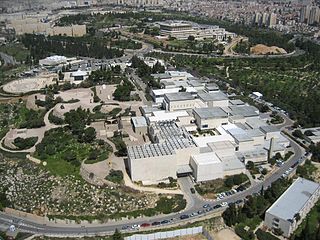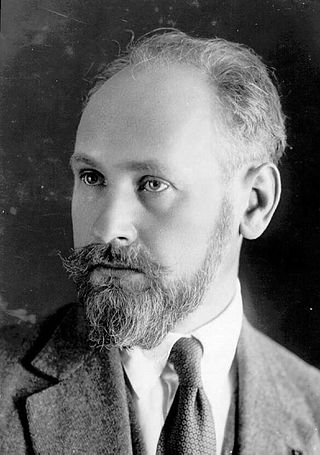
Jerusalem is a city in the Southern Levant, on a plateau in the Judaean Mountains between the Mediterranean and the Dead Sea. It is one of the oldest cities in the world, and is considered holy to the three major Abrahamic religions—Judaism, Christianity, and Islam. Both the State of Israel and the State of Palestine claim Jerusalem as their capital city. Israel maintains its primary governmental institutions there, and the State of Palestine ultimately foresees it as its seat of power. Neither claim is widely recognized internationally.

The New-York Historical Society is an American history museum and library in New York City, along Central Park West between 76th and 77th Streets, on the Upper West Side of Manhattan. The society was founded in 1804 as New York's first museum. It presents exhibitions, public programs, and research that explore the history of New York and the nation. The New-York Historical Society Museum & Library has been at its present location since 1908. The granite building was designed by York & Sawyer in a classic Roman Eclectic style. The building is a designated New York City landmark. A renovation, completed in November 2011, made the building more accessible to the public, provided space for an interactive children's museum, and facilitated access to its collections.

The Israel Museum is an art and archaeology museum in Jerusalem. It was established in 1965 as Israel's largest and foremost cultural institution, and one of the world's leading encyclopaedic museums. It is situated on a hill in the Givat Ram neighborhood of Jerusalem, adjacent to the Bible Lands Museum, the National Campus for the Archaeology of Israel, the Knesset, the Israeli Supreme Court, and the Hebrew University of Jerusalem.

Bezalel Academy of Arts and Design is a public college of design and art located in Jerusalem. Established in 1906 by Jewish painter and sculptor Boris Schatz, Bezalel is Israel's oldest institution of higher education and is considered the most prestigious art school in the country. It is named for the Biblical figure Bezalel, son of Uri, who was appointed by Moses to oversee the design and construction of the Tabernacle. The art created by Bezalel's students and professors in the early 1900s is considered the springboard for Israeli visual arts in the 20th century.

Biblical archaeology is an academic school and a subset of Biblical studies and Levantine archaeology. Biblical archaeology studies archaeological sites from the Ancient Near East and especially the Holy Land, from biblical times.

The Palestine Exploration Fund is a British society based in London. It was founded in 1865, shortly after the completion of the Ordnance Survey of Jerusalem by Royal Engineers of the War Department. The Fund is the oldest known organization in the world created specifically for the study of the Levant region, also known as Palestine. Often simply known as the PEF, its initial objective was to carry out surveys of the topography and ethnography of Ottoman Palestine – producing the PEF Survey of Palestine. Its remit was considered to fall between an expeditionary survey and military intelligence gathering. There was also strong religious interest from Christians; William Thomson, Archbishop of York, was the first President of the PEF.
Archie Rand is an American artist from Brooklyn, New York, United States.

Selah Merrill was an American Congregationalist clergyman. He served as the American consul in Jerusalem.

Ze’ev Raban (22 September 1890 – 19 January 1970), born Wolf Rawicki (Ravitzki), was a leading painter, decorative artist, and industrial designer of the Bezalel school style, and was one of the founders of the Israeli art world.

Palestinian art is a term used to refer to artwork either originating from historic Palestine, as well as paintings, posters, installation art, costumes, and handcrafts produced by Palestinian artists in modern and contemproary times.

Abel Pann (1883–1963) was a Russian-born Jewish painter and print-maker who settled in the Talpiot neighborhood of Jerusalem in the early twentieth century and taught at the Bezalel Academy of Art under Boris Schatz.
The Yeshiva University Center for Israel Studies reflects the longstanding relationship between Yeshiva University and Israel. It supports research, conferences, publications, museum exhibitions, public programs and educational opportunities that enhance awareness and study of Israel in all of its complexities. The center is led by Director Steven Fine, Professor of Jewish History at Yeshiva University, and Associate Director Joshua Karlip, Professor of Jewish History at Yeshiva University.

The Derfner Judaica Museum is a cultural and educational center that provides exhibitions relating to Jewish history and contemporary Jewish culture. The museum is located in the Jacob Reingold Pavilion on the grounds of The Hebrew Home at Riverdale in the Riverdale neighborhood of the Bronx in New York City.

Steven Fine is a cultural historian specializing in 'Judaism in the Greco-Roman World' and a professor at Yeshiva University.
The Green Collection, later known as the Museum Collection, is one of the world's largest private collection of rare biblical texts and artifacts, made up of more than 40,000 biblical antiquities assembled by the Green family, founders of the American retail chain Hobby Lobby.

Visual arts in Israel or Israeli art refers to visual art or plastic art created by Israeli artists or Jewish painters in the Yishuv. Visual art in Israel encompasses a wide spectrum of techniques, styles and themes reflecting a dialogue with Jewish art throughout the ages and attempts to formulate a national identity.

Jewish paper cutting is a traditional form of Jewish folk art made by cutting figures and sentences in paper or parchment. It is connected with various customs and ceremonies, and associated with holidays and family life. Paper cuts often decorated ketubbot, Mizrahs, and ornaments for festive occasions. Paper cutting was practiced by Jewish communities in both Eastern Europe and North Africa and the Middle East for centuries and has seen a revival in modern times in Israel and elsewhere.

Ludwig Blum was a Moravian-born Israeli painter. He emigrated to Israel in 1923, as part of the Third Aliyah, and became known as "the painter of Jerusalem".

Tobi Kahn is an American painter and sculptor. Kahn lives and works in New York City and is on the faculty at the School of Visual Arts.

Françoise Grossen is a textile artist known for her braided and knotted rope sculptures. She lives and works in New York City. Grossen’s work has been acquired by the Metropolitan Museum of Art, New York; the Renwick Gallery, Smithsonian American Art Museum, Washington, DC; and the State Hermitage Museum, Saint Petersburg, Russia.

















